- Home
- Beyond Basics
- Pastel-paper
- Traditional Pastel Paper
My Traditional Pastel Papers - Reviews for Pencil Artists
Welcome to my detailed look at Traditional Pastel Papers!
As we discussed in the main pastel paper guide, these classic surfaces are often an artist's first introduction to working with pastel pencils.
They typically offer a lovely array of colours, a range of subtle textures, and can be more budget-friendly, making them great for practice and for achieving beautiful results with a thoughtful approach.
On this page, I'll be sharing my in-depth, hands-on reviews for several popular traditional pastel papers. For each one, I've put them through their paces with both my Cretacolor pastel pencils and my trusty Faber-Castell Polychromos (to see how they fare with dry coloured pencils too!).
You’ll find:
- My honest observations on how each paper feels to work on.
- Close-up photos of my test swatches.
- Specific pros and cons I discovered for pastel pencil use.
- My verdict on their suitability for different approaches.
This is a detailed page as I cover six different papers! If you're looking for information on a particular paper, please do use the Table of Contents below to jump directly to that review. Otherwise, feel free to browse through them all.
My hope is that these detailed insights will help you choose a traditional pastel paper that you'll really enjoy working with. Let's get started!
Daler Rowney Ingres Pastel Paper (Cream)
Ingres is a classic name you'll often see associated with traditional pastel paper, widely available from UK suppliers and often recommended as a starting point due to its affordability.
This tinted paper has two distinct sides: one with a noticeable "laid" (ribbed) texture, like fine parallel lines, and another that's usually somewhat smoother, though the texture can still be apparent.
For this review, I conducted some tests on a cream sheet, specifically looking at how it performs with Cretacolor pastel pencils and also with a Faber-Castell Polychromos dry coloured pencil.
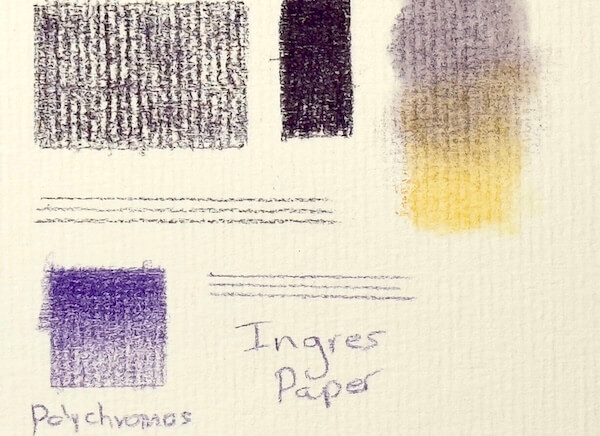 Test swatches of Cretacolor pastel pencils and Polychromos dry coloured pencils on Daler Rowney Ingres paper, showing the pronounced interaction with the paper's ribbed texture.
Test swatches of Cretacolor pastel pencils and Polychromos dry coloured pencils on Daler Rowney Ingres paper, showing the pronounced interaction with the paper's ribbed texture.How Pastel Pencils Perform on Daler Rowney Ingres
My observations from testing the Daler Rowney Ingres with Cretacolor pastel pencils were quite telling.
As you can see in my top left test swatch, even a single light layer of pastel pencil clearly picks up the ribbed line texture of the Ingres paper. This very visible texture was one of the main things that I found quite off-putting when I first tried pastel pencils on this type of paper many years ago.
When attempting to build up one, two, and then three layers (second swatch on top row), the pencil 'squeaked' when I applied firmer pressure to try and get better coverage. This indicated a fair bit of resistance from the paper's surface.
I tried finger-blending a medium pressure layer of violet and yellow pastel pencil (top right swatch). While some blending did occur, the underlying ribbed texture of the paper remained very evident, preventing a smooth visual blend.
Drawing ruled lines with a pastel pencil also proved difficult; the lines appeared somewhat wobbly as the pencil tip tended to follow the paper's texture rather than the ruler's straight edge.
How Coloured Pencils Performed on Daler Rowney Ingres
I also tested a Faber-Castell Polychromos pencil (bottom left swatch) to see if this surface was any more sympathetic to traditional wax/oil-based coloured pencils.
Unfortunately, the paper's prominent texture was still quite visible even when layering the Polychromos.
The ruled lines also exhibited the same wobbliness due to the surface texture, making precise work challenging.
Pros for Pastel Pencils (on Daler Rowney Ingres)
- Affordable and Widely Available: This makes it accessible for initial practice or very loose, exploratory sketches where surface texture isn't a primary concern.
- Acceptable Feel for Light Work: The paper itself has an "acceptable feel" if you're just doing very light, single-layer applications.
Cons for Pastel Pencils (on Daler Rowney Ingres)
- Dominant Texture: The pronounced ribbed texture is very apparent and can be visually distracting, especially with lighter applications or if you're aiming for smooth, even coverage.
- Limited Layering: It has a limited ability to hold multiple layers of pastel pencil without the texture becoming overwhelmingly dominant and the surface resisting further pigment.
- Detail and Linework Challenges: Achieving crisp, straight lines or very fine detail can be quite challenging due to the texture.
- Surface Resistance: The paper may resist heavier pressure or burnishing attempts, as evidenced by the pencil "squeaking."
Suitability for Dry Coloured Pencils (Wax/Oil) on Daler Rowney Ingres
Based on my tests, I would say it's generally not recommended for detailed or heavily layered traditional coloured pencil work.
The ribbed texture significantly impacts smooth application and linework, making it frustrating for artists who want a refined finish with their Polychromos or similar pencils.
Best For
- Very loose, expressive sketches where the paper's texture is intended to be part of the artwork's character.
- Initial practice exercises for getting a feel for pastel pencils, with the understanding that layering and detail will be limited.
- Artists who specifically want a very visible, linear texture in their finished piece.
My Tip and Verdict for Daler Rowney Ingres
While Daler Rowney Ingres paper is often suggested as a starting point for pastels due to its affordability and availability, my tests confirm my earlier experiences: for pastel pencil work where you might desire smooth blends, good coverage, or fine detail, the distinct ribbed texture can be quite frustrating.
In fact, it's this very paper that initially put me off using pastel pencils for a long time!
If you do choose to use Ingres, I'd recommend trying the smoothest side you can find on the sheet (though both sides often show the texture to some degree) and be fully prepared for that ribbed pattern to be a prominent feature of your work.
Verdict: For artists seeking to create more refined, layered, or detailed pastel pencil projects, or for those who dislike a strong paper texture showing through, I would generally advise exploring papers with a finer, less obtrusive grain or, even better, one of the specialist coated or sanded surfaces designed for pastels.
Strathmore Pastel Paper (118gsm)
This is one of the lighter-weight traditional pastel papers available, coming in at just 118gsm.
Strathmore is a well-known brand, and papers like this are often considered for sketching or lighter pastel work. I was keen to see how this particular paper would handle both my Cretacolor pastel pencils and traditional dry coloured pencils.
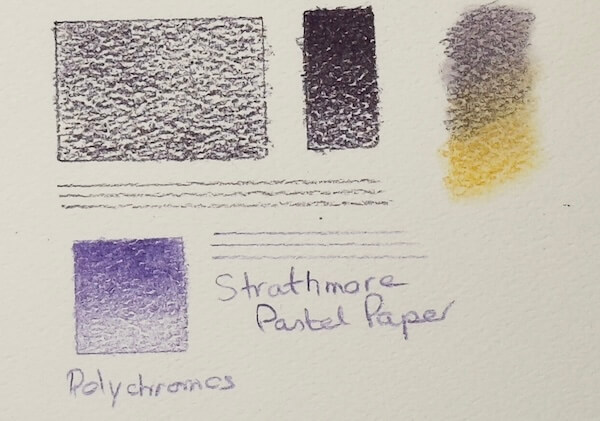 Comparing Cretacolor pastel pencils and Polychromos on lightweight Strathmore Pastel Paper; highlights limited layering for traditional coloured pencils.
Comparing Cretacolor pastel pencils and Polychromos on lightweight Strathmore Pastel Paper; highlights limited layering for traditional coloured pencils.How Pastel Pencils Perform on Strathmore 118gsm Pastel Paper
I must say, I was pleasantly surprised by this paper when using my Cretacolor pastel pencils.
Here are my observations.
Despite its light weight and an apparent texture (which you can see in the top swatches of my test photo), the pastel pencil actually glided smoothly across the surface. This was a real joy to work with, and the texture felt less intrusive than I initially expected.
With careful application, I found I could eliminate most of the paper texture by the third layer of pastel pigment. However, I felt that three layers was about the maximum this paper would comfortably take before the pigment started to resist.
When I blended the pastel pencil with my finger, it created a pleasing, slightly irregular soft texture that wasn't distracting and could be quite appealing for certain effects.
Importantly, the paper seemed quite gentle on the pencil leads, with no noticeable rapid wear-down, which is always a bonus.
Ruled lines did still pick up some of the paper's tooth and appeared slightly wobbly, but I found them to be acceptable for many applications where perfect precision wasn't paramount.
How Coloured Pencils Performed on Strathmore Pastel Paper
My experience with Faber-Castell Polychromos on this paper was, unfortunately, quite different, and it’s not a combination I would want to repeat for any serious coloured pencil work.
Although the paper's texture was visible, the surface actually felt quite smooth to the harder pencil tip.
Even a single layer of Polychromos was not particularly pleasant to apply, and after just two layers, the paper began to feel slick and resistant to further pigment.
I genuinely struggled to apply a third layer, and a fourth was impossible – I simply couldn't build up the colour depth I'd expect. The test square (bottom left in the photo) quickly took on a premature shine when angled, a sure sign it had taken as much pigment as it could and was already self-burnishing.
Interestingly, ruled lines with the Polychromos were smooth and not wobbly. This is likely because the harder pencil tip wasn't as influenced by the subtle paper texture as the softer pastel pencils were.
Pros for Pastel Pencils (on Strathmore 118gsm)
- Pleasant Application: Offers a surprisingly smooth gliding feel for pastel pencils
- Gentle on Pencil Core: Doesn't seem to wear down pastel pencil cores excessively.
- Good for Light Layering: Can take up to approximately 3 layers, allowing for soft, textured blends.
- Affordable Option: A budget-friendly choice for practice and sketching.
Cons for Pastel Pencils (on Strathmore Pastel)
- Very Lightweight (118gsm): This is its main drawback. It requires very careful handling and must be taped down securely to a board to prevent creasing, tearing, or movement, especially during more vigorous work.
- Limited Layering Capacity: Not suitable for techniques that require many heavy layers, as it will quickly become saturated.
- Linework Limitations: Not ideal if you need very crisp, perfectly straight lines or completely smooth, texture-free coverage due to its inherent surface character.
Suitability for Dry Coloured Pencils (Wax/Oil) on Strathmore 118gsm
Not Recommended. Based on my tests, the surface becomes slick far too quickly, preventing effective layering or colour build-up with wax/oil-based coloured pencils like Polychromos.
Best For (Using Pastel Pencils on Strathmore Pastel Paper)
- Sketching and practice with pastel pencils where extensive layering isn't required.
- Creating more textured work, such as landscapes or some animal subjects, where a slight irregular texture from the paper and blending can be beneficial – provided the paper is well secured to a board.
- Artists on a budget looking for a practice paper that's kind to their pastel pencils.
My Tip & Verdict for Strathmore 118gsm Pastel Paper
The Strathmore 118gsm Pastel paper was a pleasant surprise for light pastel pencil work, offering a nice glide and decent blending capabilities for a few layers.
If you're looking for a budget-friendly option for practice sketches or enjoy creating more textured pieces like landscapes, this could be a good choice, as long as you tape it down well due to its very light weight.
However, I definitely wouldn't recommend it for use with traditional wax or oil-based coloured pencils, as it simply doesn't have the capacity to take multiple layers of those mediums.
For pastel pencil work that requires very smooth application (such as some detailed portraits or still life), you might also find its inherent texture, while not as aggressive as Ingres, still a little too intrusive for a flawless finish.
Verdict: A decent, gentle practice paper for pastel pencils if handled with care, but not robust enough for heavy layering or for use with traditional coloured pencils.
Winsor & Newton 'Tints' Pastel Paper (160gsm)
Winsor & Newton, a very well-known and long-established UK art supplier, offers their 'Tints' pastel paper in an impressive range of 30 colours.
This 160gsm paper is described as being grained (textured) on one side and smoother on the other. For my tests, I focused my attention entirely on the textured side, as the reverse felt too smooth with no discernible tooth that I felt would be suitable for pastel pencil work.
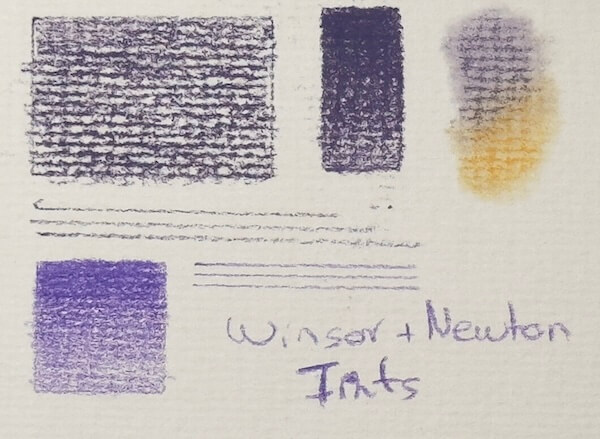 Test swatches of Cretacolor pastel pencils and Polychromos dry coloured pencils on the textured side of Winsor & Newton 'Tints' 160gsm paper
Test swatches of Cretacolor pastel pencils and Polychromos dry coloured pencils on the textured side of Winsor & Newton 'Tints' 160gsm paperHow Pastel Pencils Perform on W&N 'Tints' (Textured Side)
My experience using Cretacolor pastel pencils on the textured side of the Winsor & Newton 'Tints' paper was quite unique.
The initial application felt rather dry, not as immediately pleasant or smooth as some other papers I've tested, like the Strathmore Pastel paper.
The texture itself was very apparent and had a regular, almost 'brick-like' pattern with fine lines running in both directions. In some areas of my test sheet, I could also see faint circular or oval impressions, which I found quite strange to work with at first.
Despite this unusual and prominent texture, I was able to build up to 6 layers of pastel pencil pigment, which is a decent layering capacity for a 160gsm paper.
Blending, however, proved to be quite problematic on this surface.
I found that the pigment tended to settle into the grooves of the texture, while the colour on the 'peaks' of the texture would lift or blur when I tried to blend with my finger. This created an effect almost like using a solvent around the edges of the blended area, and the colours didn't mix well in the middle to create a smooth transition.
Ruled lines drawn with a pastel pencil took on a dashed or dotted appearance, clearly following the paper's distinct texture rather than producing a solid, crisp line.
How Dry Coloured Pencils (Polychromos) Perform on W&N 'Tints' (Textured Side)
Interestingly, my experience with Faber-Castell Polychromos (my standard oil-based coloured pencils) on this textured side was more positive than it had been on some other traditional papers.
I managed to apply 5 or 6 layers of Polychromos before the surface started to feel full and resist further pigment.
It was only with very hard pressure that the area started to show a shiny, prematurely burnished appearance. Overall, it was not an unpleasant surface for the Polychromos in terms of layering.
Ruled lines drawn with Polychromos were acceptable and less broken or dashed than those drawn with the softer pastel pencils, as the harder pencil tip was less influenced by the texture.
Pros for Pastel Pencils (on W&N 'Tints' Textured Side)
- Good Layering Capacity: For a 160gsm paper, it can take a decent number of pastel pencil layers (up to 6 in my tests) on its textured side.
- Range of Tints: The availability of 30 colours in the range offers good choice.
Cons for Pastel Pencils (on W&N 'Tints' Textured Side)
Intrusive Texture: The distinct, regular 'brick-like' texture of the grained side can be very apparent in the final work and may not suit all styles or preferences, particularly if a smooth finish is desired.
Problematic Blending: Achieving smooth blends is difficult, as the pigment tends to lift from the 'peaks' of the texture.
Broken Linework: Fine lines or ruled lines can appear broken, dashed, or dotted due to the texture.
Dry Application Feel: The initial feel of applying pastel pencil was rather dry.
Smoother Side Lacks Tooth: The reverse, smoother side of the paper had insufficient tooth for effective pastel pencil application in my opinion.
Suitability for Dry Coloured Pencils (Wax/Oil) on W&N 'Tints' (Textured Side)
The textured side performed acceptably well with Polychromos, allowing for more layers before burnishing compared to some other lighter-weight traditional papers I've tested.
However, the paper's inherent texture will still likely be a noticeable feature of the artwork.
Best For
- Artists who specifically want to exploit its unique regular texture as a deliberate visual element in their work.
- Practice sessions where achieving perfectly smooth blends or fine, crisp lines isn't the primary objective.
My Tip & Verdict for Winsor & Newton 'Tints' (Textured Side)
The textured side of Winsor & Newton 'Tints' paper certainly presented a unique challenge for my pastel pencils, primarily due to its regular, almost 'brick-like' surface pattern.
While it surprised me by taking a good number of layers for its weight, I found achieving smooth blends very difficult.
In my tests, it performed more predictably with dry coloured pencils like Polychromos when it came to layering on this textured side.
Given that the smoother reverse side felt like it had very little tooth suitable for pastel pencils, my review focused on the textured side.
If you're considering this paper for your pastel pencil work, be prepared for its distinct texture to be a strong and visible feature. I would highly recommend testing a single sheet before committing to a full pad, especially if smooth blending and subtle gradations are important to your artistic style.
Verdict: An interesting paper with good layering capacity for its weight, but its prominent texture and blending challenges make it a niche choice for pastel pencils.
More suitable for traditional coloured pencils if you don't mind the texture showing through.
Fabriano Tiziano Pastel Paper (160gsm)
Fabriano Tiziano is a well-regarded traditional pastel paper hailing from Italy, and it boasts a composition containing 40% cotton, which often contributes to a lovely feel and durability.
A notable feature of Tiziano is that it's both internally and externally sized. This sizing means it can accept some light wet media applications, which is a great bonus if you enjoy incorporating washes or watercolour pencil underpaintings into your work.
In my experience, it typically offers a soft, subtly grained surface. I found it had two usable sides: one felt slightly more textured than the other, though I would classify both as being relatively smooth and not overly aggressive.
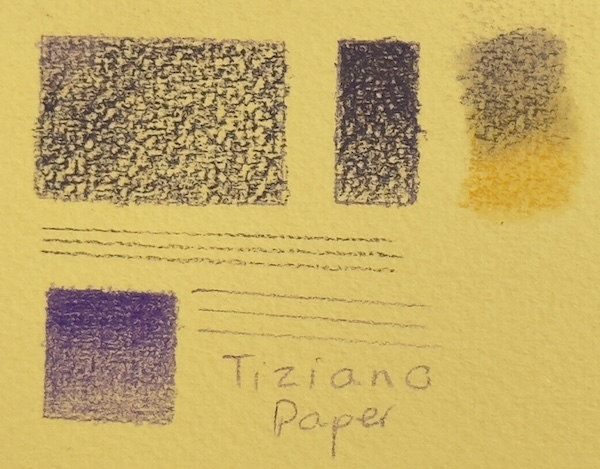 Test swatches of Cretacolor pastel pencils and Polychromos dry coloured pencils on Fabriano Tiziano 160gsm paper.
Test swatches of Cretacolor pastel pencils and Polychromos dry coloured pencils on Fabriano Tiziano 160gsm paper.How Pastel Pencils Perform on Fabriano Tiziano
I must say, I found working with my Cretacolor pastel pencils on Fabriano Tiziano to be a genuinely pleasant experience.
Here's what I discovered.
With a light application, there's just a hint of texture visible, perhaps a very fine woven grid, though it's quite subtle and not at all distracting.
I was able to build up around 6 layers of pastel pencil pigment before the surface felt like it was nearing its capacity. This allowed for a nice, solid appearance without excessive effort.
The colours blended well together on this surface using my finger, creating smooth and even transitions.
Ruled lines drawn with a pastel pencil were quite acceptable, showing minimal disruption from the paper's subtle texture, which is excellent for when you need a cleaner edge.
How Dry Coloured Pencils (Polychromos) Perform on Fabriano Tiziano
Fabriano Tiziano also performed surprisingly well with my Faber-Castell Polychromos, making it a versatile option.
It was a pleasant surface to work on with the Polychromos, feeling receptive to the pencil.
I could achieve a good 8 layers of coloured pencil before the surface started to show any shine or early signs of burnishing, which is quite impressive for a paper not solely designed for wax/oil-based pencils.
The very fine texture that was visible in my test square was not distracting at all for coloured pencil work.
Ruled lines drawn with the Polychromos were very good, appearing straight and clean even on close inspection.
Pros for Pastel Pencils (on Fabriano Tiziano)
- Good Layering Capacity: Takes approximately 6 layers of pastel pencil, which is good for a 160gsm traditional pastel paper.
- Blends Well: Facilitates smooth blending of pastel pencil colours.
- Acceptable for Detail: Allows for reasonably detailed linework with minimal texture interference.
- Dual-Sided: Offers a subtle choice in texture, though both sides are relatively smooth.
- Sized for Light Wet Media: Its internal and external sizing means you can confidently use light washes as an underlayer without immediate buckling.
Cons for Pastel Pencils (on Fabriano Tiziano)
- Not for Extensive Layering: While it takes 6 layers well, it won't offer the immense layering capabilities of a dedicated sanded or heavily coated surface if your style involves very deep, complex, multi-layered work.
- Subtle Texture Remains: The very subtle texture, though generally not intrusive, might not be desired if you're aiming for extremely smooth, photorealistic finishes where absolute smoothness is critical.
Suitability for Dry Coloured Pencils (Wax/Oil) on Fabriano Tiziano
Good. My tests showed that Fabriano Tiziano is a very capable surface for Polychromos and similar dry coloured pencils. It accepted up to 8 layers before showing signs of burnishing, which is impressive. The minimal texture is not distracting and allows for good detail.
Best For
- Artists looking for a versatile traditional pastel paper that performs admirably with both pastel pencils and dry coloured pencils.
- Creating works with moderate layering requirements in pastel pencil.
- Subjects like portraits, still life, or landscapes where a very subtle paper texture is acceptable or even desirable.
- Artists who might want to incorporate light wet media underpaintings.
My Tip and Verdict for Fabriano Tiziano
Fabriano Tiziano was a delightful surprise with its versatility and consistently pleasant performance for both my pastel pencils and my Polychromos.
While it doesn't boast the immense layering capacity of a specialist sanded paper, it confidently takes a good number of layers for both media before the tooth feels full.
With two usable sides offering slightly different (but both relatively smooth) textures, artists have a subtle choice based on their preference or the specific piece they're working on.
I would happily choose this paper for a finished piece in either pastel pencil or traditional coloured pencil, especially if I wasn't planning on extremely heavy, burnished layers that require a more robust tooth.
The fact that it's sized to take light washes is a wonderful added bonus for artists interested in mixed media explorations.
Verdict: A highly commendable and versatile traditional paper that punches above its weight, offering a lovely experience for both pastel pencils and traditional coloured pencils, especially for work requiring moderate layering.
Canson Mi-Teintes (Traditional - 160gsm)
A staple in the pastel world for many years, Canson Mi-Teintes is a popular French-made paper that artists often encounter.
It's a 160gsm sheet with a good cotton content (around 60% I believe), which gives it a quality feel, and it boasts an impressive range of approximately 50 colours.
One of its most distinctive features, and something that often causes a bit of discussion, is its dual surface: one side has a very pronounced "honeycomb" or "mechanical" texture, while the reverse side is noticeably smoother, though still with a fine grain.
For my detailed tests, I evaluated both sides independently to see how they performed with my Cretacolor pastel pencils and Faber-Castell Polychromos.
Performance on the SMOOTHER Reverse Side of Canson Mi-Teintes
This is the side I would typically gravitate towards for pencil work.
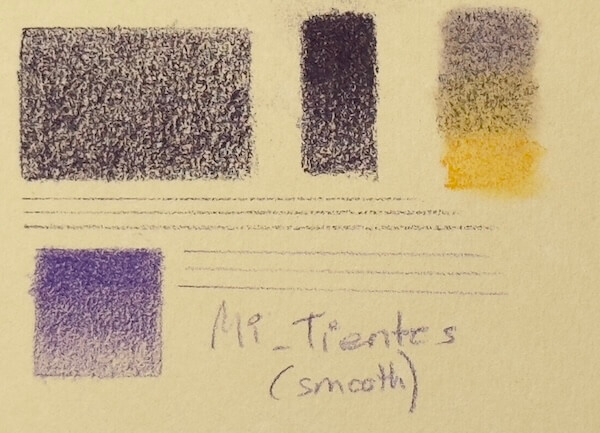 est swatches of Cretacolor pastel pencils and Polychromos dry coloured pencils on the smoother reverse side of Canson Mi-Teintes 160gsm paper.
est swatches of Cretacolor pastel pencils and Polychromos dry coloured pencils on the smoother reverse side of Canson Mi-Teintes 160gsm paper.How Pastel Pencils Perform (on the Smoother Side)
I found the smoother reverse side of Mi-Teintes to be lovely to work on with my Cretacolor pastel pencils. Here's what I noted:
- Very little of the paper's underlying textural pattern was evident, even after a single light layer, which was encouraging.
- I was able to build up to 6 layers of pastel pencil, achieving a solid fill of the tooth before it felt saturated.
- The colours blended beautifully together with my finger, creating smooth transitions.
- I found that ruled lines remained straight and true, making this side quite suitable for achieving detailed work with pastel pencils when needed.
How Dry Coloured Pencils (Polychromos) Perform (on the Smoother Side):
My Faber-Castell Polychromos also responded well to this smoother surface:
- The very fine grain of the smoother side was generally unobtrusive for coloured pencil application.
- I managed a good 5 layers of Polychromos before the surface began to feel a little slick, and I could just about 'squeeze in' a sixth layer before it would take no more pigment effectively.
- Linework with Polychromos was also very good on this surface, remaining crisp and clear.
Performance on the TEXTURED ('Honeycomb') Side of Canson Mi-Teintes
Now for the more infamous "honeycomb" side, which presents a very different experience.
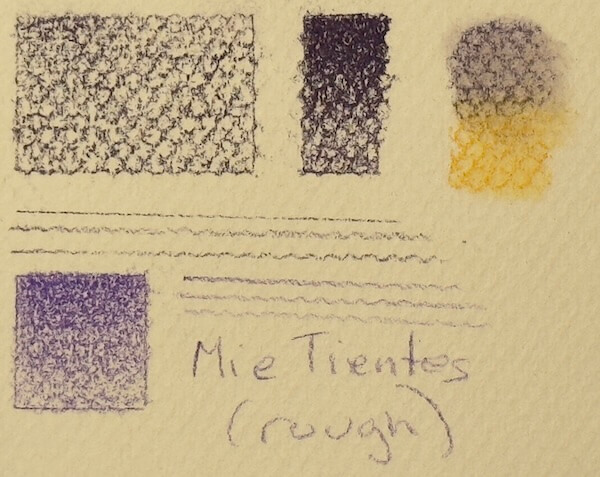 Test swatches on the heavily textured 'honeycomb' side of Canson Mi-Teintes 160gsm paper, showing significant texture interference.
Test swatches on the heavily textured 'honeycomb' side of Canson Mi-Teintes 160gsm paper, showing significant texture interference.How Pastel Pencils Perform (on the Textured 'Honeycomb' Side):
My experience with Cretacolor pastel pencils on the textured 'honeycomb' side was, frankly, quite challenging for the kind of results I usually aim for with pencils:
- If I hadn't been conducting these specific tests for this guide, I would have stopped using this side for pastel pencils almost immediately as soon as the highly pronounced texture appeared – it's simply not a surface I enjoy for detailed pencil work.
- It took a good 6 layers of pastel pencil to even begin to fill the deep tooth and somewhat reduce the visual impact of the honeycomb pattern.
- Blending was largely ineffective for creating smooth transitions. It tended to accentuate the 'darker circles with light centres' pattern of the honeycomb rather than melding the colours.
- Linework was also significantly compromised, with ruled lines coming out rather squiggly as the pencil tip inevitably followed the deep indentations of the texture.
Based on these tests, I would not recommend the textured 'honeycomb' side of Canson Mi-Teintes for most pastel pencil work, especially if you desire smooth coverage or detail.
How Coloured Pencils Performed (on the Textured 'Honeycomb' Side)
My Polychromos didn't fare much better on this rougher, patterned side:
- The texture, which I found resembled bubble wrap in appearance once pigment was applied, was too distracting for comfortable coloured pencil application.
- I only managed about 5 layers of Polychromos, and the paper already felt slippery and resistant after just 4 layers.
- Ruled lines were again squiggly and unsatisfactory.
I also would not recommend this textured 'honeycomb' side for traditional dry coloured pencil techniques if you are aiming for a smooth or detailed finish.
Pros for Pastel Pencils (Canson Mi-Teintes - Overall)
- Excellent Colour Range: An extensive range of around 50 paper colours is available, offering wonderful choices.
- The SMOOTHER Reverse Side: This side provides a very workable and pleasant surface for pastel pencil application, allowing good layering (approx. 6 layers), effective blending, and the ability to achieve good detail.
- Good Availability: Widely available in UK art shops and online, both in sheets and pads.
- Quality Feel: The high cotton content gives the paper a durable, quality feel.
Cons for Pastel Pencils (Canson Mi-Teintes - Overall)
Textured "Honeycomb" Side is Problematic: The heavily textured "honeycomb" side is, in my opinion, unsuitable for most pastel pencil techniques if you desire smooth results, leading to frustration with visible texture, poor blending, and compromised linework.
Layering Limits on Smoother Side: Even the smoother side, while good, has its limitations for very extensive, heavy layering compared to specialized sanded or coated pastel surfaces.
Best for
Exclusively using the smoother reverse side. This side is good for a wide range of pastel pencil techniques, including moderate layering, blending, and detailed work, especially when you want to take advantage of its wide colour selection for your ground.
My Tip & Verdict for Canson Mi-Teintes (Traditional - 160gsm)
Canson Mi-Teintes truly offers a tale of two distinctly different surfaces for pencil artists!
The smoother reverse side is, in my experience, surprisingly capable and genuinely lovely to work on with both pastel pencils and traditional Polychromos.
It accepts a good number of layers for a 160gsm paper, allows for beautiful blending with pastel pencils, and supports decent detail.
If you want to utilise its extensive and beautiful colour range as a coloured ground for your pencil work, this smoother side is a versatile and reliable choice.
However, I strongly advise against using the heavily textured 'honeycomb' side for any kind of detailed pencil work, whether that's with pastel pencils or traditional coloured pencils.
I found its pronounced, mechanical texture to be frustrating and quite detrimental to achieving smooth coverage, good blends, or crisp, clean lines. My advice is to always check you're working on the correct side!
Verdict: Stick to the smoother reverse side of Canson Mi-Teintes for a much more rewarding and enjoyable experience with your pencils. That side is a good all-rounder for many traditional techniques. Avoid the honeycomb!
Daler Rowney Murano Pastel Paper (160gsm)
Daler Rowney also offers the Murano pastel paper. Going back to Peter Weatherill's original notes for Pencil Topics, he mentioned it as having a 45% cotton content and being available in a good range of 35 colours. It's a 160gsm paper.
In my own testing, I found the two sides of the Murano paper to be quite similar in their fine texture.
For my test swatches, I worked on what appeared to be the slightly more textured side, though, to be honest, the difference between the front and back was minimal.
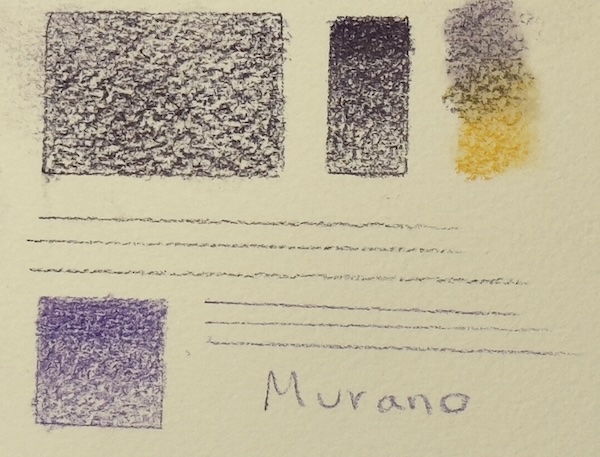 Comparing pastel pencil and Polychromos application on Daler Rowney Murano paper; demonstrates good pastel pencil handling but resistance to traditional coloured pencils.
Comparing pastel pencil and Polychromos application on Daler Rowney Murano paper; demonstrates good pastel pencil handling but resistance to traditional coloured pencils.How Pastel Pencils Perform on Daler Rowney Murano
I found the Daler Rowney Murano to be a pleasure to work on with my Cretacolor pastel pencils. Here’s what I observed:
- The surface accepted the pastel pencil pigment well from the first stroke, feeling quite receptive.
- I was able to build up a good 6 layers of pastel pencil pigment, which allowed for a decent depth of colour for a traditional 160gsm paper.
- Blending the pastel pencil colours also worked well on this surface with my finger, allowing for smooth and subtle transitions.
- For linework, my first ruled line was a little wobbly. However, I quickly discovered that using a faster, more confident pencil stroke for subsequent lines produced a much better, cleaner, and straighter result. So, technique matters here!
How Coloured Pencils Performed on Daler Rowney Murano
Unfortunately, my experience using Faber-Castell Polychromos on the Murano paper was quite disappointing, and it's not a surface I would choose for traditional coloured pencil work:
- The Polychromos colour didn't seem to have much substance or depth on this paper, appearing somewhat weak.
- It felt as though my pencil was skidding over the surface, even when applying just the second layer.
- I effectively gave up after only managing 3 layers, as the paper simply wouldn't take much more pigment effectively and showed early signs of resisting further application.
Pros for Pastel Pencils (on Daler Rowney Murano)
- Pleasant Working Surface: Feels nice to work on with pastel pencils.
- Good Layering Capability: Accepts approximately 6 layers of pastel pencil.
- Blends Well: Facilitates good blending of pastel pencil colours.
- Good Linework (with practice): Can achieve good, clean lines with a faster, more confident stroke.
Cons for Pastel Pencils (on Daler Rowney Murano)
- Linework Technique Sensitive: Initial or slow linework attempts might appear wobbly; requires a quicker stroke for best results.
- Standard Layering Limits: As a 160gsm traditional paper, it will naturally have limits for very heavy or extensive layering compared to specialist sanded or coated surfaces.
Suitability for Dry Coloured Pencils (Wax/Oil) on Daler Rowney Murano
Not Recommended. My tests showed that Daler Rowney Murano doesn't take wax/oil-based coloured pencils like Polychromos well at all. The surface feels like it resists the pencil, and layering is very limited, making it frustrating for this medium.
Best for
- Artists looking for a pleasant and reliable traditional pastel paper that handles pastel pencils well for techniques involving moderate layering and blending.
- Good for practice sessions or for finished pieces where the specific feel and good layering capacity of Murano (up to about 6 layers) suits the desired outcome.
- Those who appreciate a paper that encourages a slightly more confident, faster stroke for linework.
My Tip and Verdict for Daler Rowney Murano
Daler Rowney Murano was a surprisingly nice experience for my pastel pencils, offering good layering and effective blending for a traditional paper.
An interesting quirk I found was with linework: if you're drawing lines, a quicker, more decisive stroke seems to work best to avoid wobbles.
However, based on my tests, I definitely wouldn't choose it for work with traditional wax or oil-based coloured pencils, as it just didn't seem to accept them well, resisting the pigment almost immediately.
Verdict: Daler Rowney Murano is a good, solid traditional option if you're focusing on pastel pencil work and enjoy a surface that blends well and can take a decent number of layers. It's a good example of how a paper can really shine with one type of pencil but not be suitable for another!
Choosing Your Traditional Pastel Paper: Final Thoughts
So there you have it – a close look at six popular traditional pastel papers and how they performed under my pastel pencils and, for comparison, my Polychromos dry coloured pencils.
As a group, these traditional papers offer a wonderful entry point into working on coloured surfaces, often at a more accessible price point, and they each have their own subtle characteristics.
You'll have seen that some, like the Fabriano Tiziano or the smoother side of Canson Mi-Teintes, proved to be quite versatile and pleasant for pencil work, while others, like the heavily textured side of the Mi-Teintes or the classic Daler Rowney Ingres, presented more challenges for the kind of smooth application and detail many pencil artists seek.
An Important Note on My Testing:
It's worth remembering that many of these traditional pastel papers were originally designed with soft pastel sticks in mind, which behave very differently from pastel pencils.
Pastel sticks can fill the tooth of a paper more quickly and robustly, and artists using them often have different blending techniques and expectations for surface interaction.
My tests and reviews on this page have focused exclusively on how these papers perform with pastel pencils (specifically Cretacolor) and, for a baseline, with wax/oil-based coloured pencils (Faber-Castell Polychromos).
I haven't tested them with soft pastel sticks, so if that's your primary medium, you may find their performance characteristics differ.
Ultimately, the "best" traditional pastel paper for you will depend on your personal style, the subjects you enjoy, the level of detail you're aiming for, and how much paper texture you like to see in your finished work.
I hope my hands-on findings have given you a clearer idea of what to expect from these classic surfaces and have perhaps helped you narrow down which ones you might like to try for yourself.
There's no substitute for getting a few sample sheets and seeing how your favourite pencils feel on them!
Where to Go Next?
- To revisit the fundamental principles of choosing any pastel paper (like understanding tooth, weight, and colour), please see my Ultimate Guide to Choosing Pastel Paper for Artists.
- If you're curious about papers that offer even more tooth and layering capability, perfect for more intensive pastel pencil techniques, why not explore my reviews of Specialist Coated, Sanded and Textured Surfaces page?
- Read my in-depth thoughts on a perennial favourite in my Clairefontaine Pastelmat Card Review.
- Or, discover the uniquely soft experience of Velour Pastel Paper.
Thank you for joining me on this exploration of traditional pastel papers. I wish you the very best in finding the surfaces that bring you the most joy and success in your pastel pencil art!
Improve Your Pencil Art: Get Free Tips & Techniques
Sign up for our newsletter – just occasional emails packed with practical advice and inspiration for pencil artists like yourself








